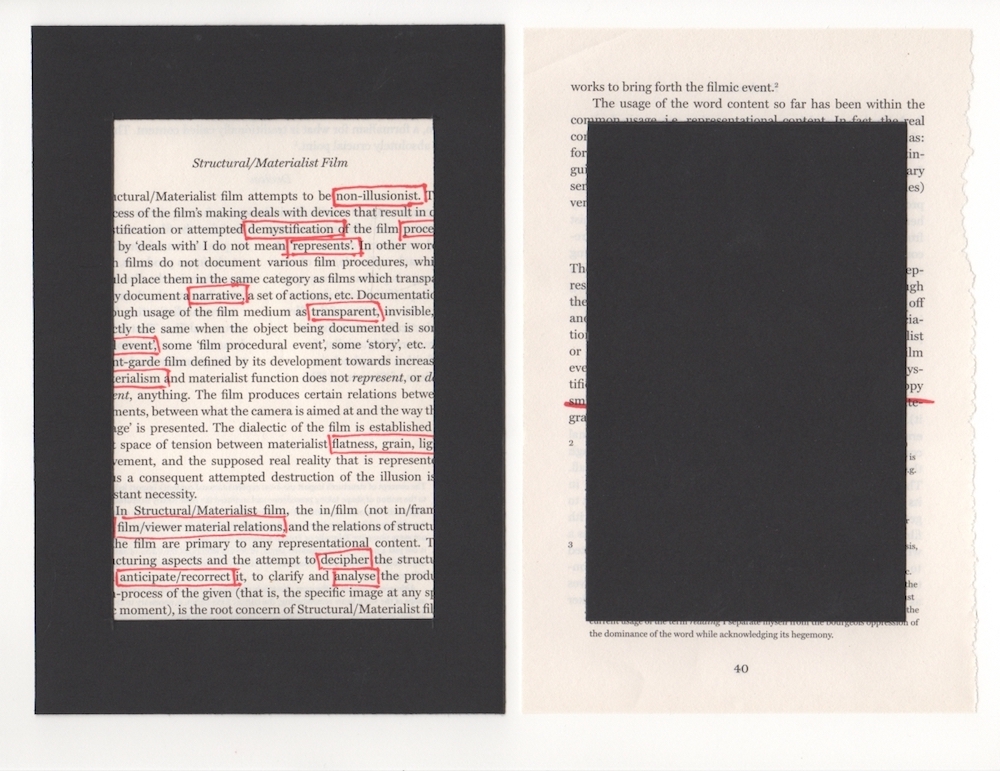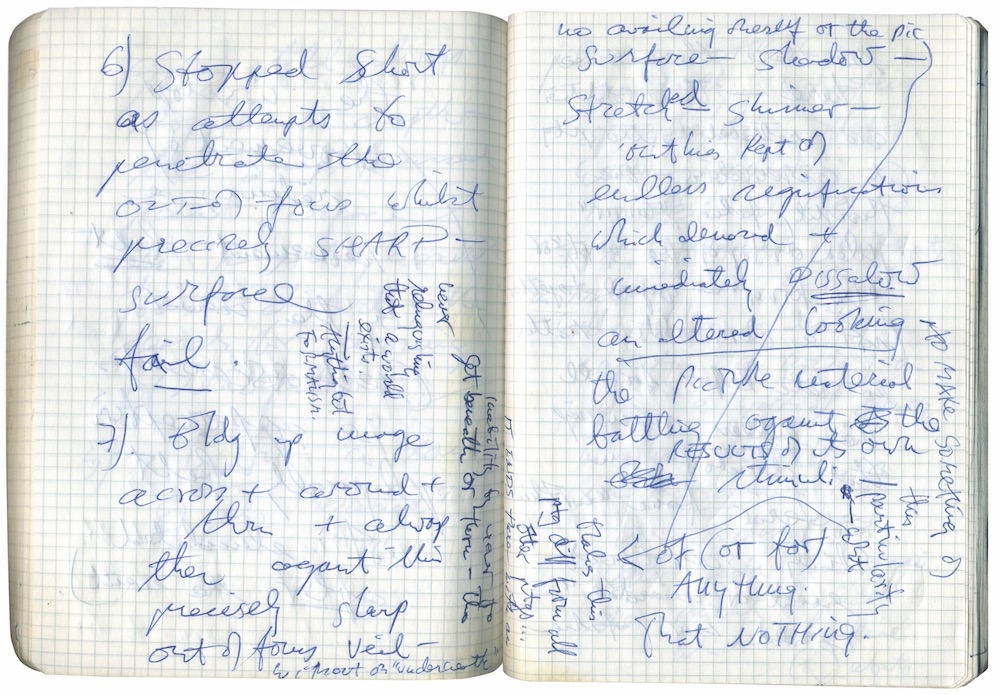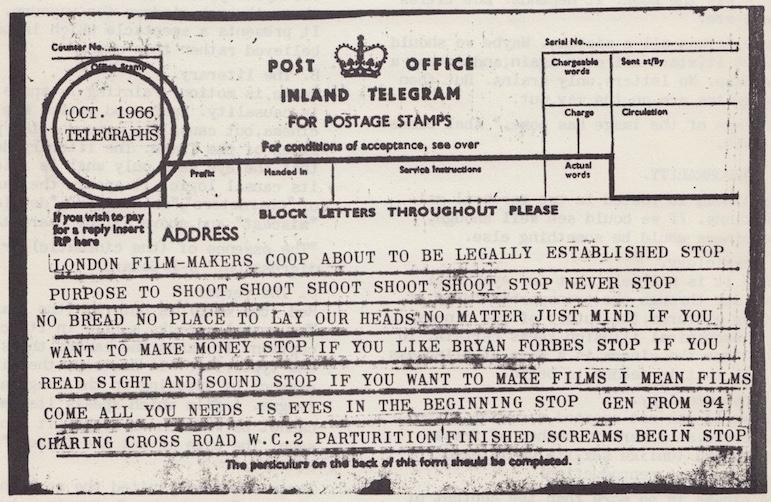This autumn, Anthology Film Archives (New York) will present several shows to mark the 50th anniversary of the London Film-Makers’ Co-operative, and celebrate the publication of Flare Out: Aesthetics 1966-2016 and Shoot Shoot Shoot: The First Decade of the London Film-Makers’ Co-operative, 1966-76. The programs are structured in three strands – Shoot Shoot Shoot, Peter Gidal: Flare Out and From Real to Reel. Details below :-
SHOOT SHOOT SHOOT: THE LONDON FILM-MAKERS’ CO-OP
The London Film-Makers’ Co-operative was founded 50 years ago in October 1966. Inspired by the example set by Jonas Mekas and his colleagues in New York, the LFMC grew from its beginnings as a film-viewing group for London’s intellectual counterculture to become one of the major centers of a worldwide network of avant-garde film culture. In contrast to similar organizations, the LFMC’s activity was not limited to distribution – within a few years it was also running a regular program in its own cinema and, most notably, democratized the means of production by establishing a film workshop in which filmmakers could control every stage of the creative process.
The work made in this supportive environment was diverse, though two tendencies came to dominate the discourse: structural/materialism and expanded cinema. The materialist qualifier that distinguished British work from the American structural film refers both to Marxist philosophy and the physical presence of the medium that was foregrounded in films produced in the LFMC workshop. European expanded cinema largely eschewed the associations of psychedelia and expanded consciousness as formulated in Gene Youngblood’s 1970 book, EXPANDED CINEMA, and instead extended the formal exploration of film to the moment of its presentation. The term was used to describe a range of work including multi-screen films, live performances, and continuous installations that made innovative use of the mechanics of projection.
Filmmakers associated with the LFMC during its early years include Stephen Dwoskin, Malcolm Le Grice, Peter Gidal, Annabel Nicolson, Sally Potter, Anthony McCall, Lis Rhodes, Guy Sherwin, and John Smith. The organization survived in run-down premises, with little or no public funding, for more than thirty years until its enforced dissolution and merger with London Electronic Arts. Since 2002, LUX has distributed the former LFMC collection and promoted its legacy alongside the work of contemporary film and video artists.
Curated by Mark Webber, Shoot Shoot Shoot: The London Film-Makers’ Co-op is presented by Anthology Film Archives in association with LUX, London.
SHOOT SHOOT SHOOT: THE FIRST DECADE OF THE LONDON FILM-MAKERS’ CO-OPERATIVE 1966-76, edited by Mark Webber, will be published by LUX in October 2016. The book gathers together texts, images, and archival documents, and is illustrated throughout in full color.
…
SHOOT SHOOT SHOOT, PROGRAM 1
Thurs, Oct 20 at 7:30pm
It was the film workshop that set the structure of the LFMC apart from other film co-ops. The facility housed a continuous processor and step printer that enabled filmmakers to work directly with the medium, without the need or expense of commercial laboratories, and provided a set of technical parameters that enabled a school of filmmaking to develop. This program spotlights works that were, more or less, produced within that environment, from the more playful films of Annabel Nicolson and Marilyn Halford, to one of Malcolm Le Grice’s early loop-based found footage meditations on the military/industrial complex. Mike Leggett’s seminal process-piece SHEPHERD’S BUSH, a measured passage from darkness to light, was conceived as a test for the Co-op’s step printer but is nonetheless a cathartic experience for the viewer. Chris Garratt’s VERSAILLES I & II and Lis Rhodes’s dynamic DRESDEN DYNAMO explore the possibilities of using visual imagery to create optical sound on 16mm film.
Annabel Nicolson FRAMES 1973, 8 min, 16mm, silent
Marilyn Halford FOOTSTEPS 1975, 7 min, 16mm, b&w
Mike Leggett SHEPHERD’S BUSH 1971, 15 min, 16mm, b&w
David Crosswaite FILM NO. 1 1971, 10 min, 16mm
Lis Rhodes DRESDEN DYNAMO 1971-72, 4 min, 16mm
Chris Garratt VERSAILLES I & II 1976, 11 min, 16mm, b&w
Malcolm Le Grice REIGN OF THE VAMPIRE 1970, 16 min, 16mm, b&w
…
SHOOT SHOOT SHOOT, PROGRAM 2
Sun, Oct 23 at 6:00pm
This second glimpse at the first decade of the London Film-Makers’ Co-op anticipates some of the new directions that followed in later years. SHORT FILM SERIES is an open-ended set of observational pieces by Guy Sherwin, each the length of a 16mm film roll. Mike Dunford’s STILL LIFE WITH PEAR wittily deconstructs the act of filming, while John Smith constructs a word game of visual puns in ASSOCIATIONS. Finally, two double 16mm projection serve as examples of British expanded cinema: Gill Eatherley’s understated feminist ‘room film,’ and RIVER YAR, William Raban and Chris Welsby’s majestic time-lapse study of a tidal river estuary.
Guy Sherwin SHORT FILM SERIES: VERMEER FRAMES/CHIMNEY/PORTRAIT WITH PARENTS/METRONOME 1974-78, 14 min, 16mm, b&w, silent
Mike Dunford STILL LIFE WITH PEAR 1973, 14 min, 16mm-to-digital, b&w
John Smith ASSOCIATIONS 1975, 7 min, 16mm
Gill Eatherley PAN FILM 1972, 8 min, 16mm double-projection, b&w, silent
Chris Welsby & William Raban RIVER YAR 1972, 35 min, 16mm double-projection
…
SHOOT SHOOT SHOOT, PROGRAM 3
Tues, Oct 25 at 9:00pm
In the early 1970s, Malcolm Le Grice, Gil Eatherley, William Raban, and Annabel Nicolson frequently collaborated on expanded cinema shows under the collective name Filmaktion. In AFTER MANET, all four appear as filmmaker/performers, sharing in a picnic while each operating a 16mm camera according to a set of instructions determined by Le Grice. The resulting images offer different viewpoints on the same event and were shot in permutations of color, black and white, positive, and negative. Originally projected as a four-screen simultaneous projection, AFTER MANET is now presented as an HD digital composite. William Raban’s rarely seen film BREATH is also a performance within a pastoral landscape. Here, three cameras (operated by Raban, Eatherley, and Le Grice) converge on a tape recorder, each shot lasting the duration of a single breath.
William Raban BREATH 1974, 16 min, 16mm-to-digital
Malcolm Le Grice AFTER MANET, AFTER GIORGIONE – LE DÉJEUNER SUR L’HERBE OR FÊTE CHAMPÊTRE 1974, 53 min, 16mm-to-digital
…
SHOOT SHOOT SHOOT, PROGRAM 4:
MALCOLM LE GRICE: NEW BFI RESTORATIONS
FILMMAKER IN PERSON!
Tues, Nov 1 at 7:30pm
Malcolm Le Grice instigated the LFMC’s move towards production, building up the workshop and sketching the blueprint for the organization’s structure and constitution in 1968. By that time, he had already constructed the rudimentary printer and developer with which he made his early work. An artist with a passion for technological developments, he was an early adoptee of computer animation, new media, and multi-channel work, and is now working in digital 3D. His first 16mm film, CASTLE 1, is a Cage-ian found-footage assemblage that requires a flashing photoflood light-bulb to be hung in front of the screen. LITTLE DOG FOR ROGER, a companion piece to George Landow’s FILM IN WHICH THERE APPEAR… and Wilhelm and Birgit Hein’s ROHFILM, embodies the materialist aspects of structural film. BERLIN HORSE (music by Brian Eno) and THRESHOLD exhibit Le Grice’s skills as a colorist, and AFTER LUMIÈRE refashions early cinema to examine the construction of meaning. These five new restorations from the BFI are being shown together for the first time on film.
Malcolm Le Grice CASTLE 1 1966, 22 min, 35mm, b&w
Malcolm Le Grice LITTLE DOG FOR ROGER 1967, 12 min, 35mm, b&w
Malcolm Le Grice BERLIN HORSE 1970, 9 min, 35mm
Malcolm Le Grice THRESHOLD 1972, 13 min, 16mm
Malcolm Le Grice AFTER LUMIÈRE – L’ARROSEUR ARROSÉ 1974, 12 min, 35mm, b&w
…
PETER GIDAL: FLARE OUT
“He draws out singularities. He allows the camera only a fenced in area, piecemeal. He lets the gaze hold on objects and constantly repeats…this permits the possibilities of the discrepancies between one’s own seeing and seeing with the camera to become distinct, and this in turn allows for a completely different experience of the surroundings.” (Birgit Hein)
For five decades, Peter Gidal has sought to problematize the film-viewing process by creating works that resist recognition and identification. His practice posits film as a durational experience and negates analysis on psychological grounds. These two programs survey his radical approach, ranging from the seminal early works HALL and CLOUDS (1969) to the recent CODA I, CODA II and ‘not far at all’ (2013).
Gidal has lived in the UK since the late 1960s and was a central figure during the formative years of the London Film-Makers’ Co-op. He is a noted writer and polemicist, whose “Theory and Definition of Structural/Materialist Film” is a key text of avant-garde cinema.
Upon the recent publication of a collection of Gidal’s essays, Jonathan Rosenbaum commented, “The singular way that Peter Gidal wrestles with language is a continual lesson in philosophy, aesthetics, ideology, and politics. FLARE OUT: AESTHETICS 1966-2016 charts his ongoing struggles with wit, lucidity, and genuine brio.”
Curated by Mark Webber, Peter Gidal: Flare Out is presented by Anthology Film Archives in association with LUX, London.
FLARE OUT: AESTHETICS 1966-2016, edited by Mark Webber and Peter Gidal, is published by The Visible Press. In addition to many texts relating to film, it also includes essays on the work of Samuel Beckett, Thérèse Oulton, Gerhard Richter, and Andy Warhol.
…
PETER GIDAL: FLARE OUT, PROGRAM 1
Sun, Oct 23 at 8:15pm
“Manipulation of response and awareness thereof: through repetition and duration of image. Film situation as structured, as recorrective mechanism.” (Peter Gidal, 1969)
The early film HALL presents a fixed view across a space of indeterminate depth that is continually disrupted by jump cuts and repeats. Despite the incessant ringing of (what may be) a doorbell, it is one of Gidal’s more accessible works. By the mid-1970s, the profilmic event had been entirely thrown into question. Variations in camera movement, lighting, exposure, focus, zooms, shot duration, repetition, and filming from photographs (rather than ‘reality’) were established as methods through which identification of/with an image could be negated. In CONDITION OF ILLUSION the image remains unstable until the final section, a scrolling text with extended quotes from Althusser and Beckett. Other works do not contain similarly readable content: FLARE OUT is “out of time in time; not not knowing the unknown but not knowing the known, no trace of ‘no trace of any thing’,” while the CODAS (commissioned by Frieze, snatches of Burroughs on the soundtrack), are “a complex of barely visible cuts in space and time, the opposite of erasure, but nothing so much as visible.”
Peter Gidal HALL 1969, 10 min, 16mm
Peter Gidal CONDITION OF ILLUSION 1975, 30 min, 16mm, silent
Peter Gidal FLARE OUT 1992, 20 min, 16mm
Peter Gidal CODA I, 2013, 2 min, 16mm
Peter Gidal CODA II, 2013, 2 min, 16mm
…
PETER GIDAL: FLARE OUT, PROGRAM 2
Mon, Oct 24 at 7:00pm
“Mental activation toward material analysis is the process that is relevant, whether or not actual structure is ‘revealed’.” (Peter Gidal, 1969)
CLOUDS was the first real manifestation of Gidal’s anti-illusionist project, a film in which “There is virtually nothing on screen, in the sense of in screen. Obsessive repetition as materialist practice not psychoanalytical indulgence.” ASSUMPTION is, by stark contrast, exhilarating viewing. One of the densest minutes of all cinema, the screen bristles with recognizable images, fleeting texts, and snatches of dialogue in tribute to filmmaker/activist Mary Pat Leece. SILENT PARTNER and EPILOGUE return to the more familiar territory of domestic interiors, inhabited spaces interrogated by a restless camera. Anti-narrative, against representation, militant and uncompromising, yet despite themselves, strangely compelling. After a hiatus from filmmaking, Gidal returned in 2013 with ‘not far at all’: “tempted to say different yet the same, but not.” The film was awarded the L’age d’or Prize at the Brussels Cinematek in 2015.
Peter Gidal ASSUMPTION, 1997, 1 min, 16mm
Peter Gidal CLOUDS, 1969, 10 min, 16mm
Peter Gidal SILENT PARTNER, 1977, 35 min, 16mm
Peter Gidal EPILOGUE, 1978, 7 min, 16mm, silent
Peter Gidal not far at all, 2013, 15 min, 16mm
…
FROM REEL TO REAL: WOMEN, FEMINISM, AND THE LONDON FILM-MAKERS’ CO-OPERATIVE
The London Film-Makers’ Co-operative is commonly associated with the 1970s and with a self-reflexive mode of filmmaking characterized by hands-on exploration of the structural and material properties of film. The two following programs seek to expand this vision by showcasing the little-know work and contributions of the women filmmakers of the LFMC from the 1970s to the mid-1990s. While these filmmakers built on the methods, processes, and ethos associated with the LFMC, they always did so to address the world outside of the projection room – to express something of their subjectivity and respond to pressing social and political issues around them. Through an engagement with the formal, material, and affective qualities of film, they hoped to give voice to submerged aspects of women’s experience and to emancipate the image, the feminine subject, and the body from the colonizing forces of patriarchal culture. These two programs are part of a larger series which was presented in its entirety at Tate Modern and Tate Britain in September this year.
Curated by Maud Jacquin, From Reel to Real is presented by Anthology Film Archives in association with LUX, London.
…
FROM REEL TO REAL: COLLAPSING THE FRAME
Mon, Oct 24 at 9:00pm
The filmmakers in this program experiment with film structure in an attempt to collapse the frame within which women are confined, both cinematic and cultural. Their films evoke feelings of entrapment and oppression at the same time as they enact a radical attack on patriarchal authority as embedded in social, linguistic, and filmic conventions. In particular, they attempt to break out of women’s “misrepresentations” by expressing something in excess of representation, both through an engagement with the rhythms and textures of images and sounds and through opening up gaps and interstitial spaces in the film texts.
Lis Rhodes LIGHT READING 1978, 20 min, 16mm, b&w
Nina Danino FIRST MEMORY 1990, 20 min, 16mm
Tina Keane FADED WALLPAPER 1988, 20 min, digital
Jean Matthee NEON QUEEN 1986, 40 min, 16mm
…
FROM REEL TO REAL: FILMIC BODIES
Tues, Oct 25 at 6:45pm
This program features works in which the exploration of the materiality of film – its physical presence as both an object and an apparatus – relates to an investigation of the body. Not only do the filmmakers reinscribe the messiness and transience of the body’s materiality as a way to relate themselves to their medium and challenge the primacy of vision in cinema; they also conceive of the film itself as a body, one that is exposed in its fragility and subjected to the same intrusive interventions as the female body in patriarchal culture.
Gill Eatherley LENS HAND SCREEN (part of LIGHT OCCUPATIONS series) 1973-74, 3 min, 16mm double-projection, b&w, silent
Gill Eatherley LENS HAND FOOT (part of LIGHT OCCUPATIONS series) 1973-74, 3 min, 16mm double-projection, b&w, silent
Gill Eatherley, HAND AND SEA FILM (part of LIGHT OCCUPATIONS series) 1973-74, 3 min, 16mm double-projection, b&w, silent
Jeanette Iljon FOCII 1974, 6 min, 16mm
Annabel Nicolson SLIDES 1976, 16 min, 16mm, silent
Sandra Lahire EDGE 1986, 8 min, 16mm
Vicky Smith RASH 1997, 7 min, 16mm
Sarah Pucill MILK AND GLASS 1993, 10 min, 16mm
Sandra Lahire SERPENT RIVER 1989, 31 min, 16mm






